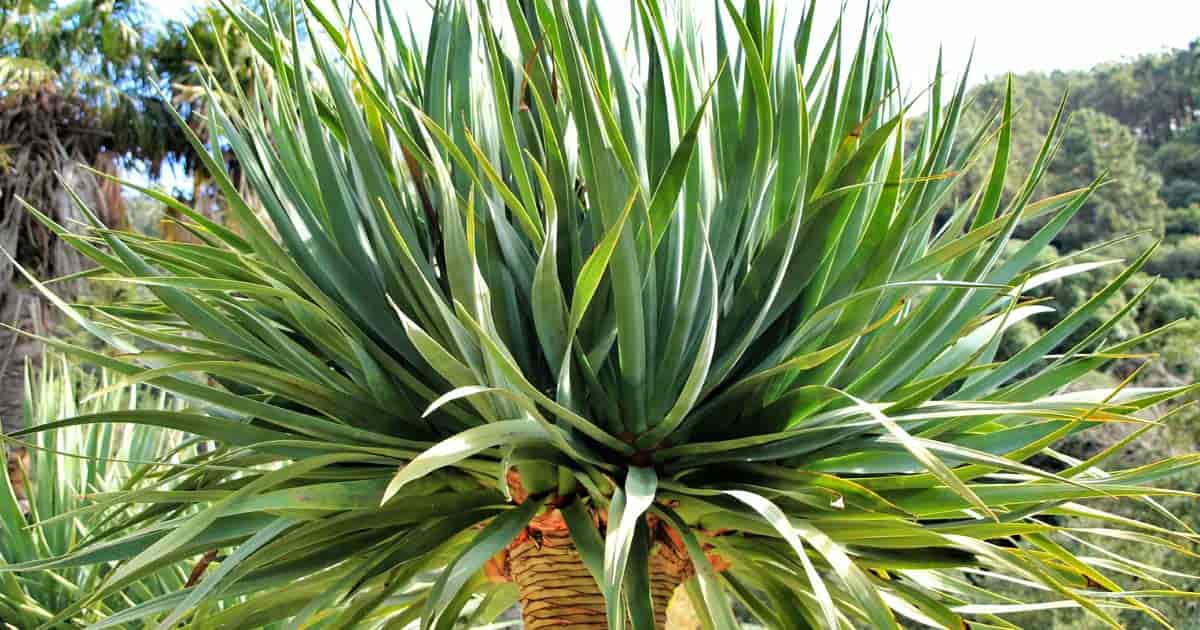The unusual tree Dracaena draco is often a hard to find Dracaena species in nurseries.
While it’s an easy plant to grow, it may eventually outgrow its available space.

Part of the Asparagaceae family, it’s native to the Canary Islands, Madeira Cape Verde and locally in western Morocco.
Dracaena draco is the symbol of Tenerife Island.
As with other plants from this Mediterranean region, it can tolerate long periods of drought.
Dracaena draco [dra-SEE-nah] [DRAY-koh] obtained the Royal Horticultural Society’s Award of Garden Merit along with various common names:
- Canary Islands dragon tree
- Blood dragon tree
- Draco tree
- Drago
- Asparagus draco
This plant will live for a very long time. One specimen on Teneriffe in the Canary Islands reached over 6,000 years old before destruction by a hurricane in 1867.
The tree trunk had a circumference of 45′ feet and a height of 70′ feet.
In the United States, you will find many fine large specimens growing in California from San Diego to the famous one growing in Balboa Park in Santa Barbara.
To try growing this captivating plant, follow the recommended plant care tips.
Draco Dracaena Tree Care
Size and Growth
Dragon trees with their umbrella shape grow into large plants and a big tree, making them difficult to fit indoors.
NOTE: Several other Dracaena varieties are more house plant friendly.
- Dracaena marginata (red edge Dracaena)
- Dracaena fragrans Massangeana
- Dracaena deremensis Janet Craig
- Dracaena Janet Craig Compacta
When the plant is young, it produces a single stem. Being a monocot it has no growth rings.
When the plant reaches about 10 to 15 years of age, the terminal bud begins to produce a flower forcing the plant to branch.
The branches grow for about 10 to 15 years before re-branching, creating an umbrella-like growth rate.
It typically takes a dragon tree about a decade or longer to mature and reach a height of about four feet.
From the top of the twisted branches, the plant produces a cluster of blue-green leaves, creating a canopy.
During the first few years, the plant resembles a small, rosette plant.
As it matures, it begins to look more like a thick palm tree.
The initial leaves are thin, long, and sharp. Use caution when moving or grooming the plant.
As the plant matures, it stores water in its trunk, allowing it to survive for long periods without water.
After cutting the trunk, a red resin may appear, which people refer to as dragon’s blood.
After the cut hardens, a permanent scar will appear, disfiguring the tree. Avoid damaging the plant to keep it unblemished.
The tree Dracaena tolerates windy conditions, salt spray, and extreme heat.
Flowering and Fragrance
The flower spike appears after about a decade after the main stem stops growing.
The lily-like flowers are white and perfumed.
After the flowers arrive, the plant produces coral-red berries.
Unfortunately, the plant may never flower indoors or outdoors in certain regions.
Light and Temperature
The dragon tree is winter hardy in USDA hardiness zones 9 to 11, surviving outdoor temperatures as low as 40° degrees Fahrenheit.
It should get bright sunlight throughout the year, whether grown indoors or outdoors.
When it gets more full sun, it produces more brilliant, more attractive leaves.
To encourage straight, upright growth, turn the pot occasionally. As with many plants, it grows toward the light.
Watering and Feeding
Water the drought tolerant plant regularly throughout the summer and feed once per month.
During the winter, allow the soil to dry between watering.
The growth will cease during the winter months, limiting the need for watering.
Soil and Transplanting
These plants require large pots to support the growing branch system.
Use a mixture of equal parts sand, pumice, and potting soil or purchase cactus soil.
Repot plants each year during the first few years of growth, moving up to a larger pot when necessary.
More on: When should you report plants?
After several years, it may become too large to repot easily.
When a mature plant reaches a larger size, freshen the top layer of soil each spring.
Grooming and Maintenance
Remove the withered leaves from the plant to help expose more of the attractive trunk. Other than this cleanup, the plant does not require grooming.
How to Propagate The Dragon Tree Dracaena
Propagate the plant from seeds. The seeds (orange berries) are about 3/4″ inch long and require sowing individually in small pots.
Use sandy soil and keep it moist, but avoid oversaturating the soil.
For the seeds to germinate, keep the pots in temperatures between 60° and 85° degrees Fahrenheit.
During this time, avoid bright, direct sunlight.
Place the pots in a warm spot with part shade.
Draco Diseases and Pests
The dragon tree doesn’t deal with many pests or diseases, but may occasionally suffer from an aphid attack, especially when it’s still a seedling.
Ideas For Using Dragon Tree Dracaenas
The drought tolerant Draco is most suitable for parks and botanical gardens as an ornamental tree. It also makes a good looking container plant in large pots outdoors.
Bark and leaves contain reddish resin the dragon blood it will secrete when cut.
The dragon’s blood has been used for traditional medicinal purposes.
